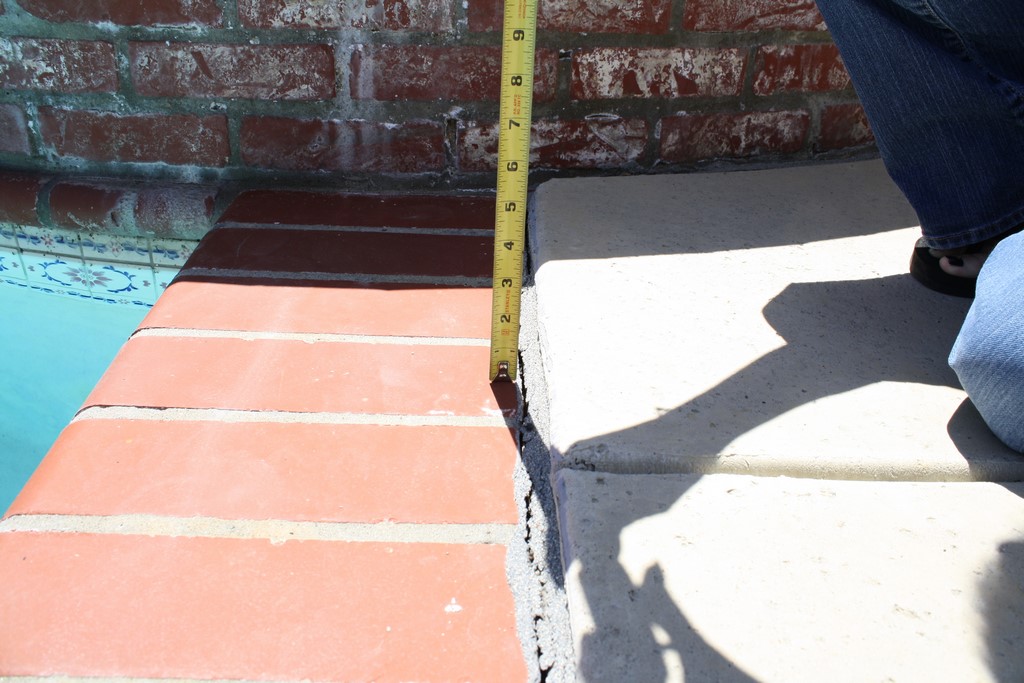Water Gone Wild

Last time, we looked at an instance in which migrating water presents mostly aesthetic challenges – scale formation, evaporation residues and other hassles that simply make a watershape look worse than it should.
This time, we’ll look into a case where the migrating water not only made the watershape look bad, but was also doing structural damage to a nearby deck and, ultimately, to the pool shell itself. It’s a cautionary tale that should make any contractor sit up and take notice, because correcting the situation in these cases can be quite costly.
The scenario: I was called in to examine a pool where there were obvious water-migration issues related to a spa spillway. The scale was unsightly, but that was nothing compared to the fact that the deck a couple feet away from the main flow had heaved up by about an inch and small cracks were beginning to appear in the plaster in the area where the heaving had occurred.
| The protruding tile sends water out and away from the brick-faced dam wall, but the flow off the sides was left free to move laterally across the surfaces on either side of the spillway. On the right side, the water made its way over to the deck, where it moved under the concrete decking and eventually caused it to heave. |
What was happening here is that the water was migrating horizontally along the brickwork at a significant-enough rate that it flowed beneath the decking and into the clay soil below, ultimately saturating the soil and making it swell. This lifting force had broken down the mastic joint between the coping and deck, increasing the water’s access to the deck’s substrate and accelerating the heaving. (I also had to question whether any waterproofing was used under the brick on the raised spa’s dam wall. The lack of this waterproofing might have added to the problem.)
The fix: The affected section of deck will need replacing, as will the elastomeric bead between it and the coping. Sealing that joint – and isolating the deck from the dam wall as well – will help address the situation, but there’s no way to guarantee that these steps will be sufficient to prevent the migrating water from reestablishing its pathways to the soil beneath the deck.
As was true in the case highlighted last time, there needs to be some sort of definite vertical break to keep the water from flowing where it’s not wanted. I will grant you that cutting a vertical channel into a brickwork pattern is visually undesirable, but that must be balanced against the problems (aesthetic and otherwise) posed by the water when it’s left to its own devices.
| These small cracks were a tell-tale sign that the heaving of the deck outside the pool was exerting pressure on the inside of the pool as well. Left unchecked, this sort of damage can become serious – and very expensive to correct. |
An even better solution would be to install a metallic weir of copper or stainless steel with proper baffles to entrain the water in a desired flow pattern. Also mentioned last time is the possibility of revising the spillway with baffles to keep the water from hugging the wall on its downward path.
Lesson Learned: It pays to be aware of the fact that water will migrate horizontally once it establishes its vertical pathways across a spillway and down a wall. So many wall finishes – ledgerstone and brick in particular – encourage this horizontal travel. As designers and builders, we need to recognize this phenomenon and develop strategies for keeping the water in desired channels.
Vertical breaks are one answer, enhanced spillway designs another – and I’d be more than happy to hear from designers and builders who’ve found additional ways to deal with and overcome the natural tendency water has to go where we might not want it to go.
Scott Cohen is a construction defect expert witness and president of The Green Scene, an outdoor design/construction firm in Chatsworth, Calif. Past articles in the Lessons Learned series have been compiled in his book, The Candid Contractor. He also provides consultation for clients nationwide and gives seminars on designing landscapes, swimming pools and outdoor kitchens. For more information, go to www.greenscenelandscape.com.














